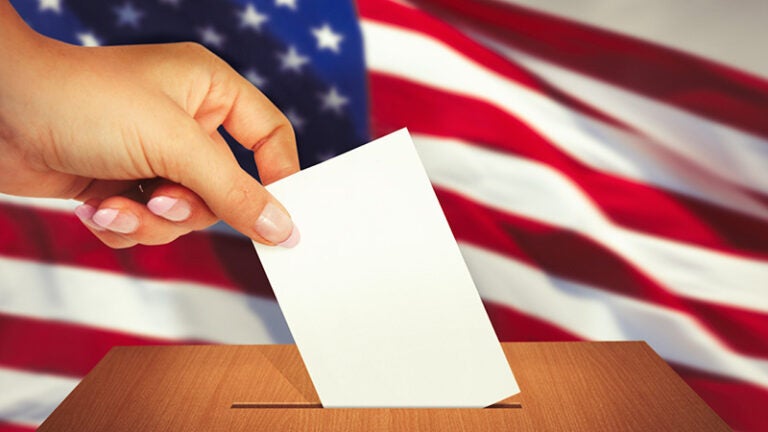
For the presidential race, ‘electability’ could decide who wins and who loses
In 2016, former Secretary of State Hillary Clinton was deemed “electable” by analysts just four years after former Massachusetts Gov. Mitt Romney carried the same label in the race against President Barack Obama, a contest that Romney lost. This election, pundits have dubbed former Vice President Joe Biden as the most “electable” Democrat among a field of more than 20 candidates, in large part because early polls, including the USC Dornsife/Los Angeles Times poll, indicate he is the favorite so far.
The dictionary definitions of “electable” and “electability” are obvious, but in practice the meaning of those terms is much more nuanced, say experts from USC Dornsife College of Letters, Arts and Sciences.
“It more or less depends on the circumstances,” says Robert Shrum, director of USC Dornsife’s Center for the Political Future. “Go back to Jimmy Carter in 1976, when he was running against President Gerald Ford. It looked like then he could push the long-lost South to the Democrats. He was ‘electable.’
“In 2004, Democratic candidate Howard Dean led the polls in Iowa and national polls for months,” Shrum adds. “But then, as people got to the point of voting, they asked themselves, ‘Who is presidential?’ And he wasn’t it.”
U.S. Sen. John Kerry, D-Mass., won the Democratic nomination that year and narrowly lost the election to Republican George W. Bush.
“Electability” also depends on who the candidates are, as well as the social and political atmosphere in the leadup to the election. “For Democrats this year, electability is really about who can win against Trump,” Shrum says.
Measuring ‘electability’
What does that leading candidate look like?
Back in April, 56% of Democratic voters who participated in a USC Dornsife/L.A. Times national poll said they chose a generic “white male” as having the best chance of winning against Trump.
Biden was leading in the poll then, and he leads still. July results of the poll released this week show Biden ahead, with 28% of Democratic primary voters, followed by a three-way tie between U.S. Sens. Bernie Sanders, I-Vt., with 11%; Elizabeth Warren, D-Mass., at 10%; and Kamala Harris, D-Calif., at 10%. It is early in the campaign season and a quarter of voters remain undecided; 50% had changed their minds since April.
However, Biden is seen as most electable by many who do not support him at this time. A third of Harris, Sanders and Warren supporters indicated that they thought Biden, not their own candidate, has the best chance to win out of all the Democratic candidates, according to the latest poll. The results further buoy impressions that he is electable — at least among Democratic voters, although many are undecided.
“As pollsters at this early stage of the race, we are interested in measuring voters’ changing perceptions of candidates electability,” says Jill Darling, polling director of the USC Dornsife/L.A. Times poll which is conducted by the USC Dornsife Center for Economic and Social Research in partnership with the Center for the Political Future.
“Generic electability is something that voters worry about, but in many recent races, it doesn’t make a difference,” Darling adds. “For example, in 2008, it may have been Obama’s’ charisma and lack of baggage that carried the day against an opponent (U.S. Sen. John McCain, R-Ariz.) seen as much more electable on paper.”
It’s impossible to measure charisma. But pollsters always try to measure electability by probing voters’ opinions and preferences.
“In the past, pollsters have asked voters questions like, ‘Could you vote for an African American man? Could you vote for a woman?’” Darling says. “We were trying to get at whether these characteristics would be measurable liabilities for the candidates.”
She adds: “In the case of Barack Obama and Hillary Clinton, did misogyny trump racial anxiety, or was it Obama’s innate ability to connect with voters that secured the Democratic nomination? These are questions that are not easily answered in the moment because voters may not be able to articulate why they feel the way they do. And with Trump, we saw something similar happen — a candidate’s ability to connect with voters, which lifted him beyond what were seen as his limits and liabilities.”
Judges of electability
The term “electable” has no scientific basis.
“Often, voters think the candidate they like most is also the most electable, under the reasoning that since that candidate appeals to them, they’ll appeal to everybody,” says Mike Murphy, co-director of the Center for the Political Future. “Often what D.C. pundits mean by ‘electability’ is not anything like how actual voters see it, through their own lenses.”
It’s just part of a sales pitch that campaign strategists make to voters to sway support toward their candidate, says Jane Junn, professor of political science and gender studies at USC Dornsife.
“People use the term as if it were empirical,” she says, “but it isn’t. It’s like saying that a dog is ‘cute.’ It’s subjective. This really goes to how we use language in this age. It’s very imprecise and off-the-cuff.”
The strategists who dub their candidates as “electable” also usually overlook the fact that voters, ultimately, are the judge of a candidate’s electability.
Who are those judges?
Based on historic voter turnout, the largest voting demographic is women.
In 2016, 54% of the voters who turned out for the presidential election were women and 46% were men, Junn notes.
“This set of numbers is for 2016, but the crazy thing about these proportions is that women have outnumbered men in the electorate since the time of ‘Mad Men’”—the 1960s, Junn says. “Back in 1964, the electorate was 51.5% female and 48.5% male.
“In 2016, there were almost 10 million more women than men in the electorate. The modal voter isn’t Don Draper. It’s Betty Draper.”